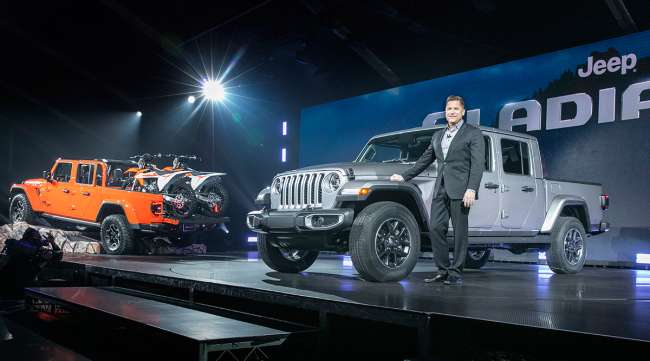Jeep Brings Gladiator to Small-Truck Fight After Market Doubles

Jeep, the crown jewel of Fiat Chrysler Automobiles NV, is re-entering the popular midsize truck market for the first time in more than two decades.
Sales of smaller pickups have surged in the past few years, and Fiat Chrysler, with its Jeep and Ram brands, hasn’t had a dog in the fight since it discontinued the Dodge Dakota in 2011. Ram will add a midsize truck in 2022, according to the company’s latest five-year plan, but in the meantime, the Italian-American automaker is relying on the brand magic of Wrangler to haul in some extra profits.
The Gladiator, which debuted at the Los Angeles International Auto Show, looks like a Wrangler with a pickup bed, which makes sense because it is based on Jeep’s best-selling product. But Tim Kuniskis, who took over Jeep from now-CEO Mike Manley just last month, is pitching Gladiator as a dedicated truck, like its 1980s ancestor of the same name.
Gladiator “is a midsize pickup; it’s going to compete in that segment, and it’s going to set the benchmark,” Kuniskis said at a preview in Auburn Hills, Mich., earlier this month. “But, by design and by plan, you can’t look at this and not think Wrangler.”
To bolster Gladiator’s truck cred, Fiat Chrysler lengthened the Wrangler wheelbase by 19 inches and gave it a modified high-strength steel frame, adding 400 pounds in the process. The new model still has Wrangler’s fold-down windshield, removable top and doors, and 4-wheel drive to go off-roading.
Gladiator is the first Jeep pickup since the Comanche, which Chrysler discontinued in 1992. It’s coming to a party that started about four years ago, when General Motors Co. revamped its Chevy Colorado for a segment Ford Motor Co. and Fiat Chrysler had abandoned to Japanese automakers, who popularized smaller pickups in the United States during the 1970s and 1980s.
Sales of these trucks have doubled since 2014 and will surpass a half-million units globally this year, according to IHS Markit, with GM and Toyota Motor Corp.’s Tacoma reaping most of the gains. The breakneck pace isn’t expected to continue: IHS forecasts sales will level off around 586,000 in 2020.
There is room for latecomers, according to IHS analyst Stephanie Brinley. Ford also is re-entering the segment next year with a new Ranger; the automaker discontinued the previous model in 2011.
“Even though we’ll see a contraction in sales, and vehicles get more expensive, it’s still a healthy market and we’ll still see opportunity,” she said.
Brinley views the Gladiator as more of a niche product “in the lifestyle side of pickup demand.” It won’t match the volumes of the Colorado or Tacoma, or even the Wrangler, but will have “good profitability,” she predicted. Fiat Chrysler sold 204,269 Wranglers in the first 10 months of this year.
Kuniskis said he’s aiming the bulk of new Gladiators at the North American market. Production at the Toledo, Ohio, Wrangler plant is scheduled to start in April, according to the United Auto Workers. The trucks will go on sale in the second quarter of 2019.
The company is mum on pricing, but Cass Burch, who owns a pair of Chrysler, Jeep, Dodge and Ram dealerships in south Georgia, said he hopes the new pickup will cost between $35,000 and $45,000, depending on the trim level. Prices for the 2019 Colorado will range from $20,500 to $40,900, according to market researcher Edmunds.
Midsize trucks have made a comeback in part because their larger siblings — the Ford F-150, Chevy Silverado and Ram 1500 — have gotten so expensive. The price differential between a full-size Silverado and a midsize Colorado, for example, is almost $10,000 today, versus about $6,500 a decade ago, according to Edmunds.

